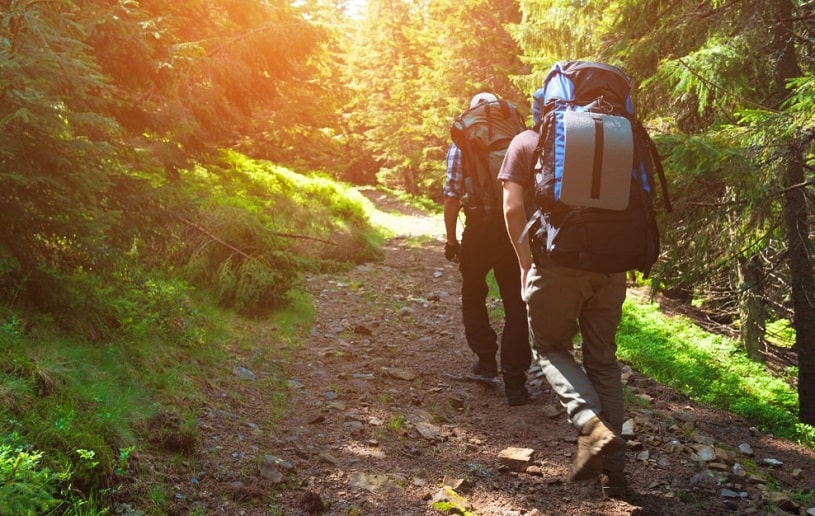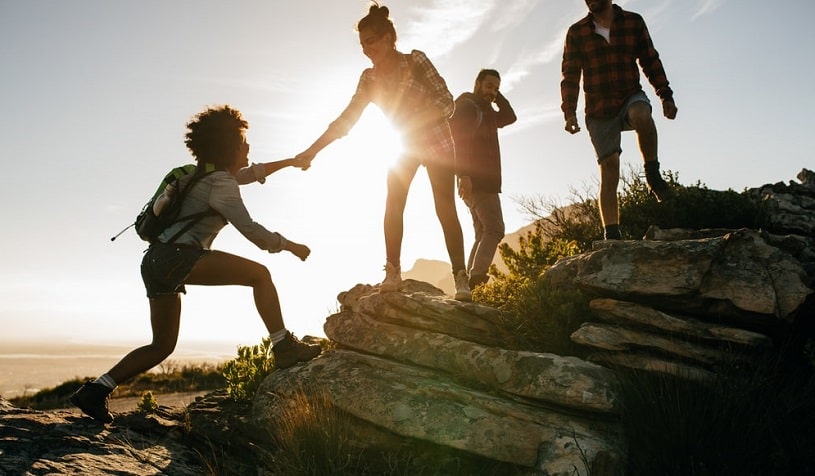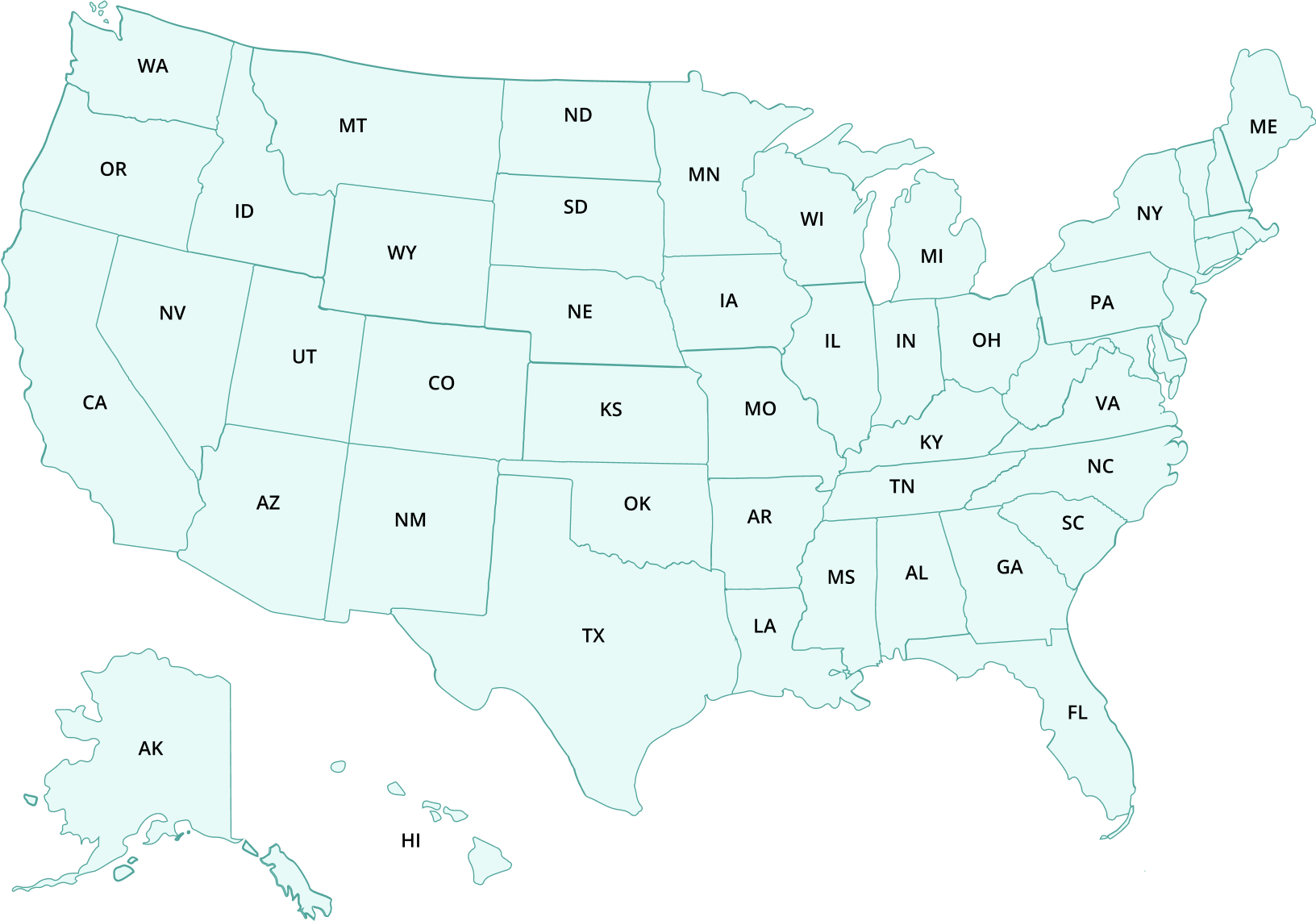What is adventure therapy (AT)? True to its name, adventure therapy is the approach of using various types of adventure as a form of experiential therapy in the treatment of certain health conditions and disorders. The idea behind it suggests that it should be done outdoors, but some of the activities involved can be carried out indoors. Take a look at the origins of adventure-based therapy and how to apply it in the treatment plan for substance abusers and other health disorders.
Table Of Contents:
What Is Adventure Therapy?
Adventure therapy is a type of experiential treatment, which also includes eye movement desensitization, psychodrama, and music therapy. As suggested earlier, adventure therapy can be very effective as a natural mental health treatment option for managing many health disorders. This type of treatment promotes emotional healing by taking the patient out into an environment they’re usually not in. When the patient gets removed from their regular environment, which might also be contributing to their deteriorating mental health, it allows them to reflect. They usually have no contact with their family or everyday life in the unique experience and see things differently. Not only that, getting a break from their regular lives and then coming back can help them piece together what they need to change in their lives to get better.

It is generally helpful for people struggling with different sorts of challenges and problems in life. Although people of all ages and backgrounds can give this a shot, research has proven it to be exceptionally successful for teens. A 2012 study showed that teens that used adventure therapy had decreased severity of their mental health symptoms than those that didn’t—showing that it may be worth giving this experience a shot.
The Approach Can Be Adopted in the Treatment of Cases Such As:
- Anxiety disorders
- Post-traumatic stress disorder (PTSD)
- Substance abuse
- Codependency
- Trauma
- Problems with anger management
- Adolescents struggling with behavioral or emotional problems
- Depression
- Grief
- Low self-esteem or self-confidence
- Families or close friends dealing with conflict
Adventure and Wilderness Therapy
Although adventure therapy and adventure wilderness therapy are used interchangeably, they’re not quite the same, just similar. AT focuses on the “thrill” and adventure of being outdoors; it is “adventure-based therapy.” Some games and challenges keep the patient busy and fully immerse them into the environment. These challenges and games are part of controlled programs laid out ahead of time, and the patients run through them one by one. This type of addiction therapy usually comes with a fee because there’s a lot of planning that goes into it.

Adventure wilderness therapy is a little different. In wilderness therapy, you don’t have the usual, controlled challenges. Instead, patients get to camp out, and immerse themselves into the “real wilderness,” and become “one with nature.” The time out from regular lives can help slow down the otherwise fast-paced way everyone lives their lives, bringing in the sense of control and helping self-reflection. Wilderness therapy all over the world may look different considering the wilderness each area has. The patients learn as they go with both forms.
How Does Adventure-Based Therapy Work?
Adventure-based therapy works based on artificial challenges that can help promote a better relationship with one’s mind and body. To accomplish this, people struggling with similar problems are grouped.
Then, they’re taken into the wilderness and handed a set of challenges. These challenges can be anything from hiking a challenging trail, kayaking in rough waters, to hanging off a cliff with nothing but a rope to protect them. Even though this doesn’t sound like a relaxing time, it’s supposed to be that way. That provides the brain enough stimulation that the patient can, for a while, be totally distracted from their everyday worldly problems and only focus on the challenges at hand. Next, counselors join the patients to help them navigate their feelings and accomplishments and relate them to their problems, allowing them to deal with them from a new perspective.
A study from 2014 showed that adventure-based treatment helped subjects learn about themselves in a way they hadn’t done before. They could dig deeper into who they are through self-evaluation, self-exploration, self-reevaluation, self-acceptance, and self-realization. Knowing exactly where they stand and who they are helped them navigate through their unique problems that stem from their disorders, addiction, or otherwise, better than those who didn’t participate in adventure-based therapy at all.
Some people react well to this therapy without contact with their family, but sometimes that’s precisely where the problem lies. That is why there are specialized programs where not only are the patients in touch with their family; their family is also there with them throughout the experience.
Adventure Therapy Activities for Addiction Treatment
Adventure-based therapy all around the world may differ slightly; however, the basis lies in going outside, where they can be in direct contact with nature, and participating in challenging adventure therapy activities such as:
- Kayaking
- Swimming
- White water rafting
- Canoeing
- Paddleboarding
- Camping
- Rock climbing
- Hiking
- Caving
- Snowboarding
Challenging activities like these will put the patients in a position where they need to leave their everyday problems aside and focus all of their energy on completing the task at hand. They’ll have to self-reflect, along with working with a team, work on their communication and problem-solving skills, and learn how to trust themselves and other people. Once these skills have been introduced, they can be worked on to translate into their daily lives in terms of improved psychosocial functioning, which can help against addiction battles.
The Types And Elements Of Adventure Therapy Program
A downside of the emergence and growing popularity of this program is that it can be hard to pick the most suitable programs for the individual’s needs. However, a credible program must – in all cases – adopt a hands-on approach that will aid the participants in learning new and healthy behavioral and emotional skills.
The Inclusion of the Following Elements Can Judge the Measure of Effective Adventure Programs:
Clinical Support
It can be done in the form of weekly individual or group substance abuse therapy sessions. Each approach has its own merits. Mental health group activities for adults, for instance, have the advantage of helping participants meet people that may be struggling through similar problems. In addition, the effect of empathy on the participants’ recovery can prove to be very useful in these cases.
Individual sessions will promote a deeper dive into each participant’s struggles, making the process of developing personalized strategies for coping and recovery easier.
Wilderness Environment
Exposure to an outdoor environment alone is sometimes enough to trigger many emotional and psychological benefits. These benefits are usually the hallmarks by which the success of an adventure therapy program is judged, so they must not be underestimated. For participants who come into the adventure therapy program feeling lost or stagnant, putting them in these outdoor environments as part of a therapeutic adventure program can be very effective. No matter how intense or relaxing the atmosphere may be, wilderness therapy provides enough challenge to most people to promote their healing journey.
Sequenced Adventure Activities
These include physical activities such as kayaking, horseback riding, rafting, surfing, backpacking, etc. While engaging in these activities, the participants are encouraged to deal with situations and obstacles that are unfamiliar. Thus, completing the activities gives them a new perspective about facing challenges and other difficult situations in life.

Cultural Immersion (Optional)
It is a less common feature among these programs, so the lack of it is not necessarily a drawback. However, it can be a good addition where present.
The idea is to remove the participants from their comfort zones and place them where the culture and values are different from what they are used to. For example, if a participant is in a situation where things that are seen as basic (such as good, clean water, or standby healthcare) are a luxury, it serves as a cause for reflection and a better appreciation of the situation they are accustomed to.
The Benefits Of Adventure Therapy
Adventures have quite many fantastic benefits for individuals of all age groups. It is particularly useful for individuals dealing with some mental or psychological stress or mental health challenges.
Some of These Benefits Include:
- It helps the participants to gain first-hand experience of the healing effects of nature which is therapeutic
- It encourages participants to take part in real-world, engaging experiences
- It enables the participants to shed some bad habits while developing new ones from the adventure therapy program they partake in. It happens because behavioral patterns are easier to change when the host is removed from the environment that fosters those patterns and habits
- It is an excellent opportunity for self-reflection and personal development. It gives the participants ample room to work on themselves
- It encourages the participants to stay active physically, leading to an overall improvement in their physical condition
- It enhances problem-solving and cognition skills through participation in tasks that require mental exertion
- It encourages an overall improvement in the participants’ outlook on life and a more positive attitude in facing challenges and fears
- It helps to build self-confidence and interpersonal communication skills
- It gives the participants a better idea of the strengths and weaknesses that they possess
- It builds trust in oneself and in others
Integrating Adventure Therapy Into A Treatment Plan
Even though the effectiveness of AT in managing different health disorders is established, it should not be deployed as a standalone treatment. It works best as part of a broader, more comprehensive non 12-step recovery program – mainly when dealing with people with severe mental health disorders.

The key here is to enroll in treatment programs with adventure therapy activities as an optional extension of the more extended program. Ideally, the comprehensive program should include talk-based therapy, like REBT or DBT therapy techniques, together with pharmacotherapy as the major approach if it is not a short-term residential treatment program. NAD IV therapy can also be used, as it will provide more energy to perform activities. All these options working hand-in-hand with adventure treatment programs, will provide the best combination treatment for a wide range of health disorders listed earlier.
Finally, it is essential to stress the adoption of individual treatment. While group sessions have their merits, taking time out for extra individual sessions will help the adventure therapist create the best personalized approach for treating each individual.
Find Drug Rehabilitation Centers Near You Anywhere In the US
Addiction Resource team has compiled an extensive list of the top drug rehabilitation facilities around the country. Click on the state you are interested in, and you'll get a list of the best centers in the area, along with their levels of care, working hours, and contact information. Haven't found the rehab you need? Call the toll-free helpline below for professional assistance.

- Alabama
- Alaska
- Arizona
- Arkansas
- California
- Colorado
- Connecticut
- Delaware
- Florida
- Georgia
- Hawaii
- Idaho
- Illinois
- Indiana
- Iowa
- Kansas
- Kentucky
- Louisiana
- Maine
- Maryland
- Massachusetts
- Michigan
- Minnesota
- Mississippi
- Missouri
- Montana
- Nebraska
- Nevada
- New Hampshire
- New Jersey
- New Mexico
- New York
- North Carolina
- North Dakota
- Ohio
- Oklahoma
- Oregon
- Pennsylvania
- Rhode Island
- South Carolina
- South Dakota
- Tennessee
- Texas
- Utah
- Vermont
- Virginia
- Washington
- West Virginia
- Wisconsin
- Wyoming
Hope Without Commitment
Find the best treatment options. Call our free and confidential helpline
Most private insurances accepted
Page Sources
- Norton, C. L., Tucker, A., Russell, K. C., Bettmann, J. E., Gass, M. A., Gillis, H. L., & Behrens, E. (2014). Adventure therapy with youth. Journal of Experiential Education, 37(1), 46-59. https://citeseerx.ist.psu.edu/viewdoc/download?doi=10.1.1.938.3995&rep=rep1&type=pdf
- Van Hoven, L. J. (2014). A systematic review of wilderness therapy: Theory, practice and outcomes. https://sophia.stkate.edu/cgi/viewcontent.cgi?article=1282&context=msw_papers
- Epstein I. (2004). Adventure therapy: a mental health promotion strategy in pediatric oncology. Journal of pediatric oncology nursing : official journal of the Association of Pediatric Oncology Nurses, 21(2), 103–110. https://pubmed.ncbi.nlm.nih.gov/15125554/
- Russell, K. C., Gillis, H., & Kivlighan, D. M. (2017). Process factors explaining psycho-social outcomes in adventure therapy. Psychotherapy (Chicago, Ill.), 54(3), 273–280. https://pubmed.ncbi.nlm.nih.gov/28922006/

 Authored by
Authored by  Reviewed by
Reviewed by 